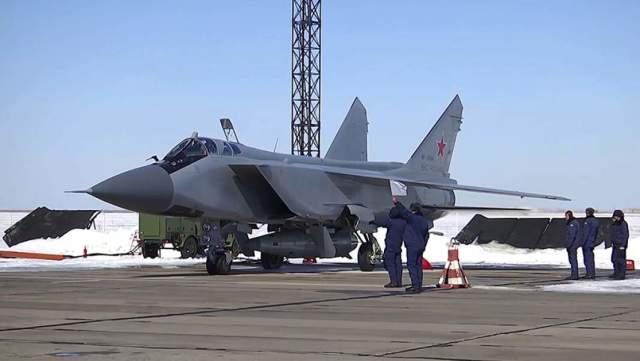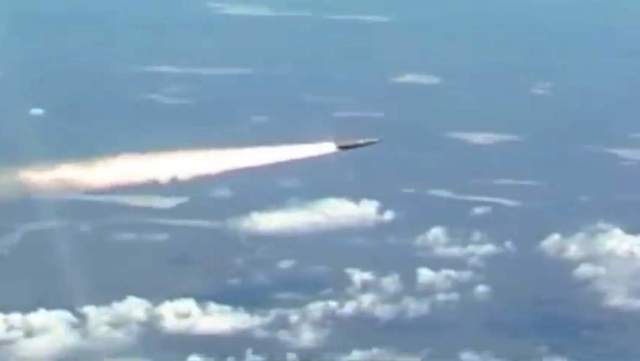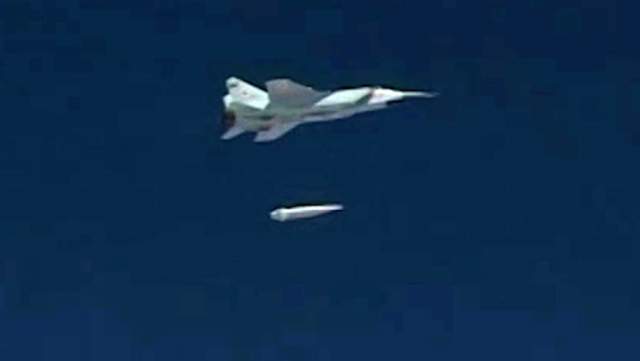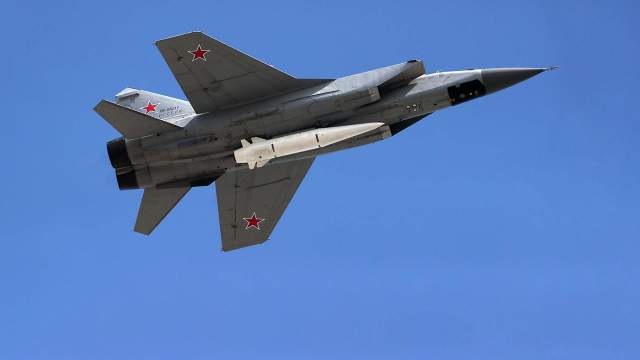It can destroy any target within a radius of several hundred kilometers in a matter of minutes
In December, information appeared in foreign media about the use of hypersonic Kinzhal missiles by the Russian Aerospace Forces at the VFU airbase in Starokonstantinov. It is from this base that Ukrainian Su-24M bombers with Storm Shadow missiles regularly strike Russian rear targets. There is no doubt that the Russian "Daggers" have reached their goal — it is impossible to defend against their blows. Izvestia figured out how a new hypersonic missile works, capable of destroying any target within a radius of several hundred kilometers in a matter of minutes.
An irresistible blow
Foreign media reported that the launch of the Dagger was carried out from the airspace of the Lipetsk region, which means that the missile's flight range was more than 800 km. And the flight time is less than five minutes. That's how fast hypersonic complexes strike — in a matter of minutes. How does it work?
The MiG-31 carrier aircraft with a missile is on combat duty in the air. He may not know in advance which target to hit — it is determined literally in real time by intelligence means. It should not be otherwise: enemy aircraft will not stand and wait at the airfield when they are destroyed — they are either distributed to dispersal airfields, or hide in protected hangars and shelters.
So, intelligence reports the target to the headquarters, where a task is being formed to strike a "Dagger" at a specific object — it contains coordinates and a specially prepared map of the area indicating the target. This can be a real radar image or a synthesized image.

Supersonic fighter-interceptor MiG-31K with hypersonic missile "Dagger"
Image source: Photo: RIA Novosti/Ministry of Defense of the Russian Federation
The information is transmitted to the carrier aircraft via a closed communication channel. Next, the on—board weapons control system works - the target image is entered into the memory of the missile's homing system, and the coordinates are converted into a flight task. Then the launch point is calculated, and the aircraft goes on a combat course.
Next, the coordinate systems of the rocket and the aircraft are synchronized — at the time of launch, the munition must know where it is located. The carrier accelerates and gains altitude — in fact, the MiG-31 in the complex performs the role of the first stage of a hypersonic missile — sets the initial altitude and flight speed at the desired point in space.
Conventional rockets that launch from earth take fuel and time to achieve such conditions, but here it actually begins its flight, having an altitude of about 20 km and a speed of about two speeds of sound.
The launch takes place when the carrier aircraft reaches the parameters set for launch - coordinates, altitude, speed. Then the rocket flies completely autonomously.

The launch of the Dagger cruise missile at the Kapustin Yar test site as part of the exercises of the strategic deterrence forces. 2022
Image source: Photo: TASS/Ministry of Defense of the Russian Federation
The first stage of the flight is when the rocket engine is running — the active part of the trajectory. At this time, it is controlled by aerodynamic rudders, but as the altitude increases, they lose their effectiveness. This is not a big deal — they are duplicated by gas rudders, which are in the flow of gases from the combustion chamber of a solid-fuel engine.
While the engine is running, the rocket is gaining altitude, the air becomes rarefied and its resistance decreases. And then the rocket goes into a more horizontal flight and accelerates to 10 speeds of sound. And then, after stopping the engine, it flies by inertia.
But the Dagger, like the Iskander-M, is controlled along the entire flight path. These are conventional ballistic missiles that fly like a thrown stone after the engine stops. And hypersonic ones are controlled and can perform maneuvers.
Firstly, their aerodynamic rudders continue to work — the air is discharged at altitude, but the speed is enormous, and the rudders can change their trajectory.
Secondly, such rockets have an additional gas—dynamic control system: inside there is a separate gas generator engine and several nozzles that can turn it in any direction.
Supersonic fighter-interceptor MiG-31K with hypersonic missile "Dagger" during tactical flight exercises with Tu-22M3 long-range aircraft of the Russian Air Force
Image source: Photo: TASS/Ministry of Defense of the Russian Federation
Thus, even in sparse space, the rocket is fully controllable and can perform maneuvers. What for? To counter missile defense and adjust its flight to the target.
Missile defense is very fond of direct—flying warheads and missiles - their trajectory is easy to calculate and they are easy to hit. If the ammunition is maneuvering, then the anti-missiles begin to miss. And if the missile also has false targets and traps, then the fate of missile defense systems in general becomes unenviable. They're hitting past.
Once near the target, the Dagger turns on its radar homing system and begins to compare the image embedded in its memory with what it sees at a given time. And as soon as the pictures match, the guidance system will direct the missile to the aiming point — right at the target!
And the still controlled Dagger will go to the target. In this way, high accuracy is achieved — the miss is in units of meters.
The account is open
The Daggers have already won quite a few victories in a special military operation. This is the defeat of the first American Patriot air defense system delivered to Ukraine near Kiev in May 2023. And repeated attacks on industrial and logistics centers. It is extremely difficult to repel a blow with a "Dagger".
On December 19, in his reporting speech at the board of the Ministry of Defense, Sergei Shoigu said that the production volumes of high-precision hypersonic missile systems Kinzhal and Zircon would be increased by 1.8 times.

Launch of hypersonic missiles "Dagger" as part of the exercises of the strategic deterrence forces "Thunder-2022"
Image source: Photo: RIA Novosti/Ministry of Defense of the Russian Federation
And there are now more than two dozen carriers of these missiles. And, apparently, in the long-range aviation of the Russian Aerospace Forces, the formation of new special—purpose squadrons with MiG-31I - the most modern carriers of the Dagger missile system - is in full swing.
And taking into account the organization of the work of reconnaissance and strike complexes, these aircraft can be effectively used for operational and instant destruction of any important targets detected by intelligence - everything is textbook and very effective.
Dmitry Kornev

